What is a pulsar?
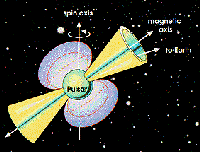 A pulsar is a rapidly rotating neutron star, one of the strangest objects in the cosmos. When a massive star runs out of nuclear fuel, the inner region simply collapses as it cannot support the outer layers of the star anymore. During this collapse, the inner regions atoms are 'crushed', squeezing electrons and nuclei together to form nothing but neutrons and billions of neutrinos. A pulsar is a rapidly rotating neutron star, one of the strangest objects in the cosmos. When a massive star runs out of nuclear fuel, the inner region simply collapses as it cannot support the outer layers of the star anymore. During this collapse, the inner regions atoms are 'crushed', squeezing electrons and nuclei together to form nothing but neutrons and billions of neutrinos.
During this process, the outer layers are blown off with energies that momentarily exceed all the energy radiated by the entire galaxy - yielding a supernova. Within, the collapse stops suddenly only if the mass of the inner region is about 1.5 times that of the Sun, leaving an incredbily hot (10 billion degrees!) rapidly spinning (up to 500 times a second) highly magnetized ball of superconducting(!) neutrons - a neutron star - about the size of Dublin Bay.
These spinning neutron stars are the most stable clocks in the Universe, more accurate than any ever built here on Earth. The interaction of the spinning intense magnetic field is the production of phenomenal electric fields that accelerate enormous streams of plasma along the magnetic poles - and it's the light produced by these streams that 'beams' out at us. Hence the term 'pulsar'.
How are they detected?
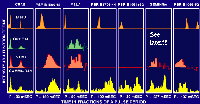 Pulsars were originally detected by accident by a young graduate student at Cambridge in 1967 named Jocelyn Bell (originally from Co. Down), and nearly all pulsar discoveries to date have been made using radio telescopes (can you think why?). Pulsars were originally detected by accident by a young graduate student at Cambridge in 1967 named Jocelyn Bell (originally from Co. Down), and nearly all pulsar discoveries to date have been made using radio telescopes (can you think why?).
The beams of radiation produced by the rapidly spinning neutron star are like a lighthouse, and should we here on Earth be in the path of the beams, we will detect extremely regular pulsations from something incredibly small - like a 20 km neutron star. The radiation emitted by these intense beams is visible all across the electromagnetic spectrum, from the radio up to gamma-rays.
The trick is designing detectors that can operate at these different wavelengths AND catch photons of light at the highest time resolution. Special instruments on board space satellites study pulsars in g (gamma) rays, X-rays and the far UV (ultraviolet). From the ground, one can observe in the optical, infrared and radio. Astrophysicists from Galway are world experts at studying pulsars in optical light.
What do astrophysicists in Galway do?
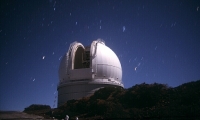 Optical light from pulsars is incredibly faint (as faint as the light of a candle on the moon - if you could light it... ) and even at the best observatories in the world, the night sky naturally 'glows'. How do we detect something as dim as a candle on the moon flickering hundreds of times a second with all the other light coming from the night sky? Optical light from pulsars is incredibly faint (as faint as the light of a candle on the moon - if you could light it... ) and even at the best observatories in the world, the night sky naturally 'glows'. How do we detect something as dim as a candle on the moon flickering hundreds of times a second with all the other light coming from the night sky?
In Galway we have developed the most advanced high speed detector systems that take pictures a million times a second. This is unique - many other detectors simply detect light but not position. With position information we can apply imaging techniques to enhance the chance to detect individual photons from these pulsars. We have used this detector, called TRIFFID, at observatories all over the world - from the Canary Islands to Chile, from Spain to the Russian Caucasus Mountains.
What have astrophysicists in Galway discovered?
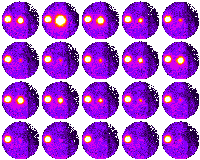 Before we started our work, only 3 optical pulsars were definitely known - the Crab pulsar (discovered in 1969), the Vela pulsar (1977) and the pulsar PSR B0540-69 in the Large Magellenic Cloud (1988). Since then, we have discovered pulsations from 2 more - the pulsar PSR B0656+14 (1997) and the pulsar Geminga (1998). In fact we believe we may have detected a faint signal from the last great supernova of the last century, SN 1987A... Before we started our work, only 3 optical pulsars were definitely known - the Crab pulsar (discovered in 1969), the Vela pulsar (1977) and the pulsar PSR B0540-69 in the Large Magellenic Cloud (1988). Since then, we have discovered pulsations from 2 more - the pulsar PSR B0656+14 (1997) and the pulsar Geminga (1998). In fact we believe we may have detected a faint signal from the last great supernova of the last century, SN 1987A...
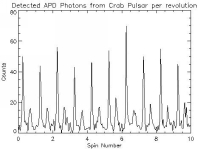 Using our various data analysis techniques we have made important discoveries about the processes that power pulsars, limiting the sizes of the emission region far out in the pulsar's magnetosphere, and uncovering an important relationship (like a 'law') that explains their emission. Using our various data analysis techniques we have made important discoveries about the processes that power pulsars, limiting the sizes of the emission region far out in the pulsar's magnetosphere, and uncovering an important relationship (like a 'law') that explains their emission.
We have also measured the size of one! We believe the neutron star known as Geminga is no greater than 10km in radius. This is a very important result for fundamental physics, as the nuclear behaviour of matter in intense gravitational fields is unknown - estimating the size of a enormous 'nucelon' like a neutron star would be a very important result.
What are we doing now?
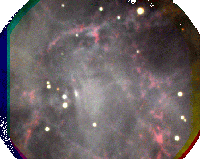 We are designing very complex computer simulations of how the emission process functions in a pulsar - these high performance calculations will use the new NUI, Galway supercomputer which will be operational before the end of the year. We are building new optical detector systems to use with ground based telescopes and hopefully try and see 'further' into the cosmos for light from these amazing stars. We are also using space observatories (like the Hubble Space Telescope and the Extreme Ultraviolet Explorer) and the great radio telescope arrays (like the Very Large Baseline array in the United States and the MERLIN interferometer in the UK) to gather together more data from which we will try and discover what makes these objects `tick'! We are designing very complex computer simulations of how the emission process functions in a pulsar - these high performance calculations will use the new NUI, Galway supercomputer which will be operational before the end of the year. We are building new optical detector systems to use with ground based telescopes and hopefully try and see 'further' into the cosmos for light from these amazing stars. We are also using space observatories (like the Hubble Space Telescope and the Extreme Ultraviolet Explorer) and the great radio telescope arrays (like the Very Large Baseline array in the United States and the MERLIN interferometer in the UK) to gather together more data from which we will try and discover what makes these objects `tick'!
High resolution images of the Crab pulsar/nebula
|

